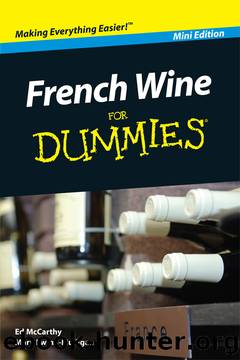French Wine For Dummies by Ed McCarthy

Author:Ed McCarthy
Language: eng
Format: epub
Publisher: John Wiley & Sons, Ltd.
Published: 2010-12-08T00:00:00+00:00
Chapter 4
Sparkling Champagne and Wine from Other French Regions
In This Chapter
Champagne from Champagne, France
Vintage versus non-Vintage
The great Champagne houses
The hearty reds of Southwest France
Yellow wines and straw wines
Is there a better-known, more popular wine in the world than Champagne? When it comes to sparkling wines, the sparkling wine we call âChampagneâ has no peer. We can seriously debate what the best red wine, white wine, or dessert wine is, but itâs no contest for the best sparkling wine.
The last part of this chapter gives you a taste of some of the many other wine regions in France. For lots more on these and other regions, check out the big book of French Wine For Dummies (published by Wiley).
What Champagne Is
Champagne is a white or rosé sparkling wine that starts its life like any other wine â as the fermented juice of grapes. But a subsequent, vital step transforms Champagne, and all the other serious sparkling wines of the world. Bottle the wine with yeast and a little sugar-wine solution, and it undergoes a second fermentation; this time, the bottle traps the carbon dioxide (a by-product of fermentation), so that it takes the form of tiny bubbles in the wine. Voila! You have Champagne â at least you do if this process takes place in the Champagne region of France. And thatâs the catch. True Champagne comes only from this one wine region. All other bubbly wines are simply âsparkling winesâ â no matter what they choose to call themselves on the label.
Champagneâs climate and soil
The location of the Champagne region really pushes the envelope for grape-growing: Itâs practically at the northernmost latitudinal limit (a little below 50 degrees latitude) in which vines can be cultivated in the northern hemisphere (see Figure 1-1).
The chalky soil of Champagne is something special. As you drive through the region, you can actually see mounds of pure white chalk. The type of soil is poor for many crops, but ideal for wine grapes, which thrive in infertile soils.
As a result of the climate and soil, the grapes that grow in the Champagne region tend to be rather tiny, but have lots of concentrated nutrients. Champagneâs cool climate and its chalky, limestone soil are undoubtedly the leading factors contributing to the excellence of its sparkling wine.
The grape varieties of Champagne
Champagne is made mainly from three grape varieties:
Pinot Noir (a red wine variety)
Pinot Meunier (a red variety related to Pinot Noir)
Chardonnay (a white variety)
Most Champagnes â about 85 to 90 percent of them â are a blend of about two thirds red grapes and one third Chardonnay. A few Champagnes (less than 5 percent) are 100 percent Chardonnay (they are called blanc de blancs); fewer yet are 100 percent red grapes (and called blanc de noirs). Rosé Champagnes, a small category, are usually, but not always, made from a blend of white and red grapes.
Although Champagne is primarily a white wine, the two red varieties predominate; they make up about 72 percent of the Champagne vineyards.
Download
This site does not store any files on its server. We only index and link to content provided by other sites. Please contact the content providers to delete copyright contents if any and email us, we'll remove relevant links or contents immediately.
| Buying Guides | Cellars |
| Champagne | Collecting |
| Spirits | Whiskey |
| Wine | Wine Pairing |
| Wine Tasting |
Whiskies (Collins Gem) by dominic roskrow(42289)
101 Whiskies to Try Before You Die by Ian Buxton(42256)
Whiskies Galore by Ian Buxton(40507)
Craft Beer for the Homebrewer by Michael Agnew(17463)
Right Here, Right Now by Georgia Beers(3511)
Not a Diet Book by James Smith(2740)
Water by Ian Miller(2595)
The Coffee Dictionary by Maxwell Colonna-Dashwood(2543)
Kitchen confidential by Anthony Bourdain(2319)
Coffee for One by KJ Fallon(2017)
Smuggler's Cove: Exotic Cocktails, Rum, and the Cult of Tiki by Martin Cate & Rebecca Cate(1995)
Beer is proof God loves us by Charles W. Bamforth(1935)
Superfood Smoothie Bowls: Delicious, Satisfying, Protein-Packed Blends that Boost Energy and Burn Fat by Chace Daniella(1915)
Talking as Fast as I Can by Lauren Graham(1846)
Bourbon: A Savor the South Cookbook by Kathleen Purvis(1802)
A Short History of Drunkenness by Forsyth Mark(1732)
Eat With Intention by Cassandra Bodzak(1698)
Cocktails for the Holidays by Editors of Imbibe magazine(1635)
Colombia Travel Guide by Lonely Planet(1622)
